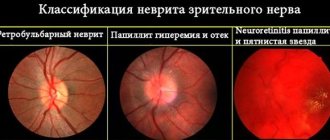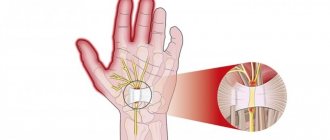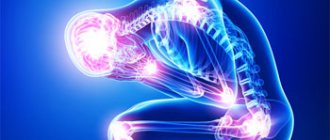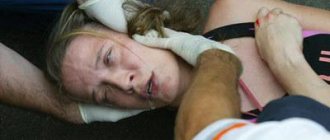When numerous dystrophic and inflammatory changes appear in the kidneys in the peripheral nerve endings, kidney polyneuritis occurs. The disease manifests itself most often in adults, but children are no exception. The problem often develops as a result of a complicated course of inflammatory pathologies, alcohol and chemical poisoning, and systemic disturbances in the functioning of the body. It is important to pay attention to the symptoms of the disease in time, since immediate therapy increases the likelihood of a complete recovery, without complications.
Etiology and pathogenesis of polyneuritis
Why does polyneuritis occur?
The disease occurs as a consequence of another illness. The disease is caused by spinal cord injury. A person also acquires the disease by being intoxicated for a long time. It happens that pathologies develop as a result of untreated glomerulonephritis or pyelonephritis. The cause of pain during polyneuritis is the inflamed parenchyma of the kidneys. In this case, a pain reaction of the nerve ending occurs. Pain indicates a physiological disorder.
With timely treatment, it is possible to improve the condition and relieve kidney inflammation in 2-3 days. Full recovery takes 1-2 months.
Frequent colds provoke the appearance of this disease.
There are main factors that provoke the development of the disease:
- frequent colds;
- long-term effect on the body of sub-zero temperatures;
- damage to the nervous system;
- deficiency of vitamins B1 and B2, B3, B5 and B6, B9 and B12;
- ingestion of a toxic chemical into the body;
- disease of the endocrine system, cancer or genetic pathology;
- intoxication due to a viral, bacterial disease or after taking an antibiotic;
- alcohol intoxication;
- after injury.
Causes and risk factors
Common causes of polyneuritis are:
- infections (viruses or bacteria, influenza, sore throat, diphtheria, typhoid, malaria);
- toxins;
- metabolic disease;
- allergens (allergic reactions);
- injuries, tumors, excessive muscle tension (impact, fall, nerve compression);
- electrical or radiation damage.
Intoxication that provokes polyneuritis can be caused by ingestion of:
- poisons (arsenic, lead);
- various solvents;
- medications with similar side effects;
- alcohol (so-called alcoholic polyneuritis occurs).
Risk factors that provoke the appearance of polyneuritis are the following diseases:
- diabetes;
- vitamin deficiency (B1, B6, B12);
- blood diseases;
- multiple sclerosis;
- hypertonic disease;
- the narrowness of the bone canals through which the nerves pass;
- working in the cold with vibrating tools.
Symptoms of kidney polyneuritis
The disease is expressed by dysfunction of the nerve pathway, resulting in impaired control of kidney function by the brain and spinal cord. Symptoms of polyneuritis at the initial stage are not clearly expressed. They can be confused with symptoms of another disease. If the nerve endings of the kidney membrane are affected, the following symptoms are observed:
Swelling of the limbs is one of the signs of the disease.
- the presence of pain, which is localized in the lumbar region;
- the patient is feeling sick;
- arms and legs swell;
- the strength of muscle tone decreases;
- burning and numbness in the limbs;
- sweating increases;
- the skin becomes pale, cold, and a frosty pattern is possible on the skin;
- tactile sensitivity of the skin is impaired.
Initial examination and diagnosis
When diagnosing a disease, a specialist, collecting anamnesis, pays special attention to the patient’s previous infections, poisonings, medications, and living conditions.
It is vaccinations and past infectious diseases that can provoke an autoimmune reaction to destroy the myelin sheath of nerves and axon degeneration.
The specialist carefully observes and studies the symptoms of polyneuritis. The symmetrical manifestation of the disorder indicates polyneuritis.
Key signs that help identify the disease upon examination:
- paralysis and paresis of the limbs;
- pain in nerves and muscles upon palpation;
- disturbance of sensitivity (so-called “stockings” and “gloves”);
- sweating of hands and feet;
- violation of skin trophism.
Doctors use the following procedures to make a diagnosis:
- electromyoneurography;
- collection of tests;
- ultrasonography;
- MRI;
- EEG.
Treatment of polyneuritis
At the initial stage, treatment is carried out for the disease that caused damage to the nerve endings. Inflammatory processes are treated with antibiotics, Sulfanilamide and Nitrofuran. Doctors prescribe Urotropin 4% or Tripaflavin 1%. If the patient’s illness occurs with pronounced pain, he is prescribed painkillers. Diuretics are used against swelling. If the disease is provoked by chemical poisoning, then the patient must be immediately protected from contact with this substance (alcohol, medicine, chemical).
If treatment is started immediately, it takes time. If treatment is not carried out, this can cause inflammation of the urinary system. Chronic polyneuritis leads to kidney failure.
In order to relieve intoxication, the patient is administered antidotes. To strengthen the body, the patient takes a glucose solution. The patient is prescribed vitamin B and bioactive microelements. They normalize the metabolic process in the patient’s body. In addition, therapy for a patient with renal polyneuritis includes a dietary diet. Doctors advise particularly neglected patients to adhere to bed rest.
Kidney diseases are expressed not only in changes in their structure or dysfunction. There is such a pathology as kidney polyneuritis.
It represents many dystrophic changes
and inflammation of the nerve endings in the kidneys. More often, the disease develops as a complication of various kidney diseases, less often it occurs independently.
Prevention of polyneuritis
Since the pathology is provoked by various factors, there are no specific measures to prevent it. General recommendations regarding the prevention of polyneuritic syndrome are:
- hardening;
- balanced diet;
- physical exercise;
- giving up bad habits such as smoking, alcohol and drug abuse;
- timely treatment of infectious diseases;
- moderate physical activity;
- good sleep;
- optimal distribution of work and rest hours;
- taking medications strictly as prescribed by the doctor;
- avoiding interaction with toxic and poisonous substances.
The main prevention of polyneuritis, like any other kidney disease, is a healthy lifestyle. Keeping your life free of alcohol, drugs and nicotine will greatly increase your chances of having healthy kidneys even in old age. It will be much easier for the excretory system to cleanse the body if you do not pollute it with additional heavy toxins that the kidneys cannot remove on their own.
Proper nutrition is also important. Correct means balanced and complete, the diet of which includes all the substances and elements necessary for a healthy body. Eliminate fatty, sweet, starchy foods as much as possible - these foods will bring you closer to obesity, since metabolism slows down with age.
Drink more mineral water and take baths with sea salt if you cannot visit the sea at least once every year or two. The elements contained there will help the kidneys stay normal and perform their function properly for many years to come.
Maintain the temperature regime, do not overcool - the kidneys react very strongly to cold, they can easily catch a cold even if there has been no external contact with a cold surface. Everyone, and especially women, is advised to dress warmly in winter and autumn, and not to overcool the lumbar and perineal areas.
What it is?
Polyneuritis is multiple lesions of peripheral nerve endings. In other words, nerve conduction is disrupted
, responsible for connecting the kidneys with the brain.
Innervation of the kidneys occurs in two ways:
- Afferent, that is, the signal goes from the organ to the brain. This process is ensured by the lower thoracic and spinal nodes.
- Efferent - the signal travels from the central nervous system to the kidneys. This is provided by the lumbar and sympathetic thoracic nodes.
There are no nerve endings in the renal parenchyma. However, they permeate the outer shell of the organ (capsule). As the inflammatory process spreads in the kidney, it enlarges and the capsule stretches. Nerve endings react to this with the appearance of pain.
If the provoking factor is not eliminated in time, the structure of the organ lining is disrupted, the electrical impulse does not pass, and as a result, kidney function decreases
.
According to the nature of the course, polyneuritis is:
- Acute - occurs as a result of a viral disease. It manifests itself as burning pain along the nerve endings, a slight increase in temperature, and aching in the limbs.
- Chronic - develops due to prolonged exposure to a provoking factor. It manifests itself as weakening of the muscles of the arms and legs; in difficult cases, speech impairment, muscle atrophy, and inflammation of the lining of the brain are possible.
What is polyneuritis
As already mentioned, polyneuritis is characterized by numerous lesions of nerve fibers. Most often, this disease does not develop independently, but occurs as a result of the manifestation of another pathology.
A distinctive symptom of polyneuritis is symmetrically flaccid muscle paresis and impaired nutrition, which entails atrophy of muscle tissue. Sometimes the disease can spread to the cranial nerves.
Differences between polyneuritis and neuritis
Neuritis is an inflammatory process of the peripheral nerve, which occurs along with dysfunction of the nerve, pain, and possibly numbness of the damaged area. This disease is based on an inflammatory process that can spread to one or more peripheral nerves.
If only one nerve is damaged, then this is a sign of neuritis (otherwise called mononeuritis). When several nerves are affected at once, we can talk about polyneuritis. This is the main difference. In addition, there are significant differences in their clinical picture, for example, polyneuritis is characterized by more severe symptoms.
Symptoms of polyneuritis
Manifestations of the disease depend on its type. Depending on the origin, the following forms
polyneuritis:
- Kidney form. Develops as a result of pyelonephritis or. The patient experiences severe swelling and weakness in the arms and legs.
- Alcoholic. Occurs after taking large doses of alcohol. It manifests itself as swelling and cyanosis of the legs, mental disorders, and decreased mobility of the limbs.
- Diabetic. In diabetes mellitus, the renal parenchyma increases. The patient suffers from severe pain in the arms and legs.
- Toxic. This form is a consequence of chemical poisoning. Lower back pain is accompanied by nausea, vomiting, and a general deterioration in health.
- Vegetative. Characterized by burning pain over the entire body.
- Infectious. Develops after infectious diseases. The patient's temperature rises and pain occurs in the lower back, radiating to the legs.
- Nutritional. It occurs due to a deficiency of B vitamins. It is characterized by shooting pains in the back, legs, and cramps.
At the onset of the disease, symptoms are mild. The patient does not associate the manifestations with kidney disease. General symptoms
kidney polyneuritis are:
Clinic of the disease
With polyneuritis, the following symmetrical symptoms are observed:
- neuralgia (severe aching or shooting pain along the entire affected nerve);
- paresthesia (tingling, numbness, goosebumps, coldness in the extremities);
- paleness or redness of the skin along the innervation of the diseased nerve, change in skin color;
- weakness;
- atrophy and muscle loss;
- painful toleration of touch, cold, heat;
- decreased sensitivity of the limbs.
Depending on the area of damage to the nervous system, the following sensitivity disorders differ:
- olfactory nerve (olfactory hallucinations);
- optic and oculomotor nerves (decreased visual acuity, limited eye mobility);
- facial nerve (paralysis, severe pain, impaired facial movement, hyperacusis, taste disorders);
- auditory nerve (hearing loss, ringing in the ears);
- vagus nerve (impaired speech, swallowing, damage to the cardiovascular system, pulmonary edema, spasms of the digestive muscles);
- phrenic nerve (pain in the hypochondrium, radiating to the neck, shoulder, shortness of breath, hiccups);
The disease is accompanied by impaired movement and paralysis, since damage to the nerve structure leads to disruption of the innervation of muscle tissue.
How are they treated?
If the diagnosis is confirmed, therapy should begin immediately
. Urgency is explained by the duration of treatment.
If the process is started, irreversible changes will occur in the kidneys.
Find out from Elena Malysheva what unfavorable factors kill our kidneys:
Many pathological complications develop. One of the common consequences of alcohol addiction is alcoholic polyneuritis or polyneuropathy of alcohol origin.
Polyneuritis due to alcohol etiology is a complication of alcohol addiction caused by toxic damage to nerve endings. Alcohol in this clinical case is the culprit of severe intoxication of the body, causing damage to the nervous system. This disease is diagnosed mainly in the stronger sex.
The pathological process is characterized by slow progression. Typically, the first alarming manifestations of pathology occur after alcohol damage to liver cells. Treatment is mandatory, and the sooner it begins, the more favorable the prognosis will be. When alcoholic polyneuritis is neglected, toxic bilateral alcoholic polyneuropathy develops, i.e. the lesion affects all the endings of the nerve trunks.
Causes and symptoms of alcoholic polyneuritis
The mechanism of development of polyneuritis of alcoholic origin is determined by chronic alcohol intoxication, leading to cirrhosis of the liver, against the background of which vitamin deficiency develops in alcohol addicts. Acute deficiency of B vitamins leads to multiple lesions of peripheral nervous system structures.
The disease appears suddenly. The initial stages of alcoholic polyneuritis are characterized by the following manifestations:
- Weakness in the lower extremities.
- Convulsive muscle contractions.
- Painful sensations in the calf muscle structures and the endings of nerve trunks.
- Then the disease is complemented by paresthesia symptoms, which are similar to the sensations after being in one position for a long time.
- Long-lasting hiccups associated with phrenic nerve lesions.
- Reduced sensitivity of the soles of the feet. When the patient steps on a hard surface, it seems to him that the floor is falling somewhere.
- Muscular joint atrophy.
- Numbness in all limbs.
- Sleep disorders.
- Chronic fatigue.
Experts note that the symptoms of alcoholic polyneuritis are inextricably linked with pathological weakness and gradual atrophic changes in muscle tissue. The pathology is often accompanied by paresis, neuritis and even paralysis. The limbs lose normal sensitivity. The pathological process may also involve the diaphragmatic, cardiac and facial neuromuscular tissues. If characteristic symptoms appear, urgent medical consultation and prescription of the necessary treatment are required.
Attention!
If the patient refuses medical care and continues to abuse alcohol, then a disruption of the pelvic organs occurs, which causes fecal and urinary incontinence.
If the patient neglects treatment, the pathological process rapidly progresses, further aggravating the condition and causing irreversible complications. Clinical manifestations such as cramps and pain in the calves periodically change in intensity, sometimes weakening, sometimes intensifying. Calm and relief are observed when stopping drinking alcohol, but if the patient starts drinking again, the painful symptoms resume with renewed vigor.
The symptomatic activity of alcoholic polyneuritis of the lower extremities can be provoked by such unfavorable factors as overwork or hypothermia, against the background of which the delivery of nutritional components to the muscles is seriously impaired. With alcoholic polyneuropathy, muscle structures weaken and decrease in volume, cyanosis occurs on the extremities, the skin peels, and nails acquire abnormal growth.
Polyneuritis of alcoholic origin can lead to very unpleasant consequences, such as disruption of short-term memory processes and degradation. The patient remembers perfectly well what happened in his distant past, but cannot remember recent events in his own life.
- alcoholic polyneuropathy usually occurs in parallel with Korsakoff's psychosis syndrome, which is characterized by confusion;
- the patient's spatial orientation is seriously impaired;
- Often patients with alcoholic polyneuritis have false memories. The patient may claim that he hardly slept at night when his household heard him snoring all night. Or the patient may say that he met an old acquaintance on the street. In reality, this person had left a long time ago, so the meeting could not have taken place.
Such patients often come up with all sorts of fables, and they themselves sincerely believe what they are telling. Involuntarily making up these stories, they do not want to lie at all; this happens unconsciously. It is almost impossible and pointless to prove to the patient that he is not truthful. Therefore, timely identification of symptoms and treatment of polyneuritis is of great therapeutic importance.
Diagnosis of polyneuritis
A specialized doctor can determine the presence or absence of such a serious disease in the early stages of the development of polyneuritis. An experienced neurologist can easily determine not only the presence or absence of the disease, but also its nature and classification. To achieve this, a number of clinical tests and medical studies are carried out:
- Collecting anamnesis and interviewing the patient. Often at this stage he already has a clear idea of the patient’s illness - characteristic complaints and visible signs allow one to determine the presence or absence of the disease.
To confirm the results of the initial survey and examination, biochemical blood and urine tests are performed. A laboratory technician will test the fluids for toxic substances.
The final stage of collecting information is the diagnosis of the endocrine and pancreas, liver and kidneys.
In order to determine the extent of damage to the peripheral nervous system and determine the stage of polyneuritis, electromyography is used - a tool for determining the electrical conductivity of muscles.
An oncologist also takes part in the diagnosis. With its help, a neurologist can differentiate polyneuritis and not confuse it with cancer.
How to treat alcoholic polyneuritis
Therapy for alcoholic polyneuropathy begins with complete cessation of alcohol and elimination of alcohol addiction. Typically therapy includes areas such as:
- Drug treatment.
- Antiviral therapy.
- Massotherapy.
- Neuromuscular stimulation.
- Acupuncture.
- Neurolysis of nerve endings.
- Vitamin therapy.
- Phytotherapy.
Such treatment of alcoholic polyneuritis will help to quickly restore muscle strength and some nerve processes. With the right therapeutic approach, pathological manifestations disappear safely. If the patient has persistent mental disorders, he is placed in an inpatient psychiatric unit.
Classification of polyneuritis
Before starting treatment, it is necessary to identify not only the form (chronic or acute) of the disease, but also its type. Depending on the reasons that led to the spread of polyneuritis, different treatments are prescribed. Polyneuritis is divided into two broad categories - axonopathic (the nerve axon dies) and demyelinating (the nerve sheath is destroyed). Further classification indicates the source of the disease:
- Infectious polyneuritis
. Occurs during inflammatory processes in the peripheral nervous system. One of the most dangerous types of pathology, since it is characterized by a large affected area and the death of many nerve fibers.
Diphtheria polyneuritis
. Occurs in 10-20% of children who have had diphtheria when the disease is not diagnosed and treated in a timely manner.
Alcoholic polyneuritis
. The inflammatory process is accelerated due to excessive consumption of alcoholic toxic substances. The development of alcoholic polyneuritis is accelerated by the constant intake of toxins and poisonous substances.
Arsenic polyneuritis
. Consequence of arsenic poisoning of the body. It does not have a chronic form, since the disease immediately becomes acute.
Diabetic polyneuritis
. Peripheral nerves of the face or limbs are damaged.
The classification is not limited to the cause of the disease. As we mentioned earlier, there are acute and chronic forms of polyneuritis. The acute form is one of the most dangerous manifestations of polyneuritis; it develops in a matter of hours or days. Most often, the acute form of the disease occurs against a background of weakened immunity and a previous infectious disease. The chronic form of the disease progresses slowly and can be easily missed by both the patient and the attending physician. The disease is growing every day against the backdrop of constant exposure to provoking factors - alcohol, poisoning, infection.
Treatment prognosis
Alcoholic polyneuritis is curable. Prompt treatment using adequate techniques will ensure successful recovery over time. If the patient persistently refuses treatment and continues to drink alcohol, then the pathology rapidly progresses, which is characterized by an unfavorable prognosis. The danger of the pathology is that along with it, side diseases are formed that can lead to death. So, if the phrenic or cardiac nerves are damaged, the patient risks dying from pneumonia, suffocation or cardiac arrest.
It is advisable for every person to know the symptoms of polyneuritis, since this disease is now common. In order for a person to move normally and perform certain functions, there is a whole system of nerve endings. Nerve endings transmit signals from the brain and control the body's adaptation to the external environment. Signs of polyneuritis include a malfunction of the peripheral nerves, which ultimately causes pain to the person and can cause disability. Acute polyneuritis of the lower extremities in most cases develops due to mechanical and toxic factors. The causes of development may also include infections such as influenza, diphtheria, dysentery, typhus, and poisoning with alcohol, arsenic, lead, and chlorophos. Often, the provocateurs of malfunction of nerve endings are harmful working conditions and vitamin deficiency.
Symptoms
Demyelinating polyneuropathy is characterized by damage to motor fibers. The patient has a disorder of deep reflexes and impaired sensitivity. Also a symptom is loss of vibration sensations and sensitive type ataxia. Clinical symptoms are represented by peripheral paresis of the lower or upper extremities. The patient has:
- discrepancy between the stage of paresis and the degree of muscle atrophy;
- prevailing weakness;
- loss of sensation in the limbs;
- thinning of the skin on the extremities (usually the hands or feet);
- cyanosis on the lower extremities, the presence of swelling and peeling;
- fragility of nails.
Chronic polyneuritic syndrome involves the formation of thickenings in the nerves, which leads to rapid sensitivity disorder. To eliminate the factor influencing nerve endings and restore the myelin sheath, it is necessary to properly treat the disease for 6–10 weeks.
Signs of disease development
Like any disease, polyneuritis has characteristic signs that can indicate it. The disease manifests itself sharply and suddenly, although it takes a long time to develop inside the body. For the first symptoms to appear, the disease must be present in the body for at least 2 weeks. The nature of the manifestation of the disease directly depends on the age of the patient; in people of retirement age, the disease develops much more pronounced.
At first, a person may complain of general malaise, weakness in the muscles of the arms and legs, depending on where the inflammation of the nerve endings occurs. Among the initial symptoms that complement general weakness and decreased muscle tone are dry skin, brittle nails, and increased sweating. It should be noted that at this stage a person may feel “gloves and socks”. On the bare foot, there is a feeling of a foreign object that slightly pinches a certain area, creating the impression of rubbing the fabric in socks or gloves. At the initial stage of the disease, there are no motor impairments, but the sensitivity of the limbs is already noticeably reduced. There are a number of cases in which sensitivity, on the contrary, increases, and a large hematoma or tumor can form at the site of a light blow.
Among the symptoms that are already beginning to alarm most people, it is necessary to note crawling and a feeling of numbness in the limbs. Elderly people cannot get rid of the feeling of chilliness in their limbs and shooting pains during calm, which can appear out of nowhere and go away just as abruptly. Weakness in the legs gradually develops. The gait becomes unsteady as foot paresis begins. The so-called rooster gait may develop, in which a person steps on his toes and falls on his heel.
Then the person ceases to feel the touch of cold and hot objects, and this is a signal that degenerative changes have begun in muscle and bone tissue. The skin on the hands and feet becomes thinner and takes on a bluish tint, the patient has difficulty holding small objects, coordination of movements is impaired, and long-healing skin ulcers may develop.
Polyneuritis
Polyneuritis is multiple nerve damage. Polyneuritis can occur after infection (influenza, tonsillitis, diphtheria, dysentery, typhoid), exogenous intoxication (poisoning with alcohol, arsenic, lead, chlorophos), endogenous intoxication (diabetes, nephritis), due to occupational hazards (working in the cold, with vibrating tools) , vitamin deficiency.
The disease begins with a feeling of crawling, coldness and numbness in the hands and feet, aching or shooting pains in the extremities, a feeling of chilliness in the arms and legs even in hot weather. Gradually, weakness in the legs, an unsteady gait develops, paresis of the feet develops, it becomes difficult to hold objects in the hands, and later atrophy of the muscles of the limbs occurs. The patient ceases to feel the touch of sharp and hot objects, as a result of which poorly healing ulcers develop. Sensory disturbances are observed more often in the distal parts of the extremities of the “gloves and socks” type. The skin on the hands and feet becomes thinner, takes on a purplish-bluish color, peels off, and swelling of the feet and hands appears. Nails become brittle, dull, and streaked.
Infectious polyneuritis occurs against the background of catarrh of the upper respiratory tract, influenza, sore throat, and is accompanied by general malaise, fever, and inflammatory changes in the blood.
Diphtheria polyneuritis can develop with late or insufficient administration of serum - on the 2-3rd week from the onset of the disease or in the toxic form on the 5-6th day of the disease. There is paralysis of the soft palate, nasal sound, and choking when eating as a result of damage to the vagus nerve. Nerves in the limbs may be damaged. In the hypertoxic form of the disease, paralysis of the respiratory muscles and damage to the cardiac fibers of the vagus nerve are possible.
Lead polyneuritis often occurs as a result of household poisoning when consuming sour jam (cranberries, lingonberries) stored in glazed earthenware. It manifests itself as damage to the radial nerves (dangling hand), combined with abdominal pain, anemia, and a lead border on the gums.
Arsenic polyneuritis can be professional and domestic (improper handling of seed mordant, poisoning with pesticides). Manifested by vomiting, diarrhea, stomach pain, paralysis of the limbs.
Diabetic polyneuritis is quite common. Usually the nerves of the legs are affected, less commonly the arms and face.
Patients experience a burning sensation and pain in the legs, chilliness and coldness of the feet, swelling of the feet, itching, and peeling of the skin.
Occupational polyneuritis occurs in people who work with vibrating tools, in the cold, in professions that require strong muscle tension (milkmaids, seamstresses, laundresses). There is pain in the hands, a burning sensation, tingling, coldness, increased sweating, and paleness of the fingertips. Symptoms increase at rest, at night, decrease with movement.
Treatment . Intravenous 40% glucose solution with 5% solution of thiamine chloride (vitamin B1) - 1 ml, intramuscular cyanocobalamin (vitamin B12) 200 mcg daily, 20 injections, orally nicotinic acid 0.03-0.05 g with ascorbic acid (vitamin C) 0.3 g 3 times a day, calcium pangamate (vitamin B15) in tablets 0.05 g 3 times a day orally. Eating yeast, liver, and rye bread, which contain a lot of vitamin B1, is beneficial. For pain, intravenous administration of a 0.25-1% solution of novocaine, 5-10 ml, 10 injections. Massage, therapeutic exercises, 4-chamber baths, paraffin, mud are shown. For diphtheria polyneuritis, treatment with massive doses of anti-diphtheria serum, subcutaneous 0.1% strychnine solution, 1 ml daily. For diabetic polyneuritis - a diet with limited carbohydrates and treatment with insulin.
The prognosis depends on timely treatment, in most cases it is favorable.
Prevention measures include reasonable hardening of the body, physical therapy, proper organization of work, and compliance with plumbing measures in enterprises where arsenic and other toxic substances are used.
Polyneuritis (from the Greek poly - many + neuritis; synonym: symmetric peripheral neuritis, multiple neuritis) - multiple inflammation of the nerves. In the past, inflammatory damage to the nerves (primary) was denied due to the prevailing idea that there were no blood vessels in the nerves. J. Cruveilhier was the first to admit the possibility of inflammation of the nerve sheaths (epineuria).
With various etiological forms of polyneuritis, either simultaneous damage to the spinal cord and peripheral nerves occurs, or sequential damage, in which the peripheral nerves are the site of the primary and, in certain phases of the disease, the dominant lesion. Guillain and Barre (G. Guillain, J. A. Barre) identified a special nosological form of polyneuritis, called the Guillain-Barre form. A very common simultaneous lesion of the roots and peripheral nerves is called polyradiculoneuritis. There are almost no pathological and clinical differences between polyneuritis and polyradiculoneuritis.
Etiology and pathogenesis. The causes of polyneuritis are varied. They can be divided into two groups: intoxication and infection. Intoxications can be exogenous (lead, arsenic, etc.) and endogenous, resulting from metabolic disorders in the body, diseases of internal organs (diabetes, kidney, liver, gastrointestinal tract diseases, intoxication during pregnancy and lactation, exhaustion due to chronic diseases ). Vitamin deficiency is given great importance in the etiology of polyneuritis. Alcohol is obviously only one of the factors causing chronic liver and gastrointestinal disease.
Most often, polyneuritis occurs with diphtheria, dysentery, and purulent diseases. In some infections, polyneuritis is caused by toxins secreted by bacteria (diphtheria, dysentery) or released during their massive decay [at the critical end of the disease (typhoid, pneumonia, etc.)]; with other infections, penetration of the infection itself into the nerves should be assumed. Viral polyneuritis, in which the virus selectively affects the peripheral nervous system, has not yet been proven, although as a component of some lesions of the nervous system, polyneuritis has been described in a number of viral diseases (lethargic encephalitis, poliomyelitis).
A special group consists of allergic polyneuritis, which develops after the administration of serums, vaccines, rabies vaccinations and as a result of a number of infectious diseases that give allergic forms of reactions. Allergic diseases also include polyneuritis that occurs as a result of the action of certain chemical (medicinal) substances, most often sulfa drugs, less often penicillin, etc. Polyneuritis in blood diseases (anemia, myeloid leukemia) is also described.
The variety of etiological factors of polyneuritis does not provide grounds for distinguishing this disease into a nosological unit. Polyneuritis should be considered as a kind of symptom complex, in the occurrence of which a complex of various causes plays a role. Thus, a lack of vitamin B1 in itself can cause polyneuritis (beriberi). In other cases, its deficiency in the body, created either due to external conditions or due to internal reasons, is a paraetiological moment, which in combination with others leads to the occurrence of polyneuritis. This is confirmed by a significant increase in polyneuritis diseases in conditions of malnutrition of the population. This is the origin of the epidemic of polyneuritis during the wars in different countries.
A significant role in the pathogenesis of polyneuritis is played by external influences (which disrupt the normal activity of the nervous system, in particular its peripheral parts), functional load (leading to its depletion), temperature influences, trauma, etc. Reactions of the nervous system to hazards, their course and the outcome depends on a number of conditions. Among the most significant of these conditions are the course of biochemical processes in the body and endocrine functions, the basic background of nervous activity, concomitant diseases and the above external influences. It may be noted that with infections and allergic forms of reaction, polyradiculoneuritis is more often observed.
Pathological anatomy. With polyneuritis, parenchymal (degenerative) and interstitial (inflammatory) changes are observed in the nerve trunks. The former should be considered as a subsequent stage of the inflammatory process in the interstitium. But it is possible that in some etiological forms, parenchymal changes occur without a previous inflammatory component, or the latter is very short-term in nature, leaving no noticeable changes. This is apparently the case with some neurotropic (chemical) poisons, vitamin deficiency polyneuritis, and diphtheria intoxication.
Parenchymal changes are limited to either the breakdown of the myelin sheath (periaxial neuritis) or the degeneration of the axial cylinders (axial neuritis). Changes in the myelin sheath are often intermittent, segmental in nature (segmental periaxial polyneuritis of Gombo).
With periaxial polyneuritis, the axial cylinders are not always destroyed; then the conductivity through them is preserved, but qualitatively changes. In axial polyneuritis, degeneration of the axial cylinders occurs according to the Wallerian type (death of all elements of the nerve fiber downward from the area of nerve damage). In the affected areas, usually not all nerve fibers of the bundle undergo decay; along with damaged fibers, they remain intact; in some fibers only myelin disintegrates; in others, the axial cylinders also die. The most resistant are the sympathetic fibers. Along with the degeneration of nerve fibers, their regeneration occurs quite quickly in the form of splitting of the axial cylinders into individual fibrils, the formation of club-shaped swellings, lateral processes, and Perroncito spirals. If the action of the disease-causing poison continues, the regenerating fibrils die.
With interstitial polyneuritis, the most pronounced inflammatory reaction occurs on the part of the mesenchymal formations of the nerve - the membranes and blood vessels. In cases where the above-described changes in nerve fibers are added to the reaction from the connective tissue, the terms interstitial-parenchymal polyneuritis or inflammatory-degenerative polyneuritis are used. Morphologically, inflammation is characterized either by an exudative reaction with the accumulation of leukocytes and edema, or by an infiltrative-proliferative process. The consequences of the completed process are the proliferation of fibrous tissue in the epineurium, thickening of the perineurium and vascular walls with sclerosis and hyalinosis of the latter. Quite often, inflammatory phenomena are also found in the radicular nerves, in the spinal nodes, and occasionally in the soft membranes adjacent to the roots or in the spinal cord (myeloradiculopolyneuritis).
The clinical picture of polyneuritis and polyradiculoneuritis consists of motor, sensory and trophic disorders; they are often accompanied by disorders of the autonomic nervous system. Movement disorders are characterized by paresis or paralysis, accompanied by muscle atrophy, decreased muscle tone and reflexion (flaccid paralysis); sensitive - pain, paresthesia and loss of sensitivity; trophic disorders are localized in the skin, nails and joints of the limbs. Depending on the etiology of the disease and the degree of damage, these disorders are combined in different ways. In relatively rare cases, the process involves cranial nerves: the vagus (often with diphtheria paralysis), oculomotor, facial, motor branch of the trigeminal nerve; these lesions are bilateral or unilateral in nature. In some etiological forms of polyneuritis (mainly with endogenous intoxications and vitamin deficiency), peculiar mental disorders are observed (see Korsakov syndrome). The process rarely spreads to the spinal nodes (polyganglioradiculitis) and the spinal cord (myeloradiculopolyneuritis).
Almost always, polyneuritis is of a mixed type (sensitive and motor), but one or another symptom may dominate. Quantitative dissociations are sometimes observed within individual types, mainly sensitive ones. In some cases, the conductors of skin sensitivity are affected while the muscle-articular sensitivity is relatively preserved, in other cases - vice versa. This last type of polyneuritis is characterized by a violation of the statics and gait of the tabic type, lack of reflexes, pain (pseudotabes neurotica, polyneuritis atactica) and is observed more often with diphtheria paralysis. Individual cases have been described where trophic and vasomotor disorders dominated the disease picture compared to sensory and motor disorders; usually these were chronic polyneuritis with a slow and progressive course.
In some cases, paralysis of the limbs is unilateral, or the process is localized in the proximal parts of the limbs, in the dorsal muscles. Sometimes the disease begins with damage to the cranial nerves, and paralysis of the limbs occurs a little later. With serum and vaccine polyneuritis, the nerves in the area of injection of the serum are sometimes affected, but then the lesion spreads. In most cases, the upper and lower extremities are simultaneously affected, but the onset of the lesion from the lower extremities (ascending nature of the process) occurs in approximately half of the cases. A special form of ascending type of paralysis with a hyperacute or acute onset, often ending in death, is the form described by Landry (see Landry ascending paralysis). There is also a so-called ascending neuritis, starting from one limb, then moving to the other.
Cerebrospinal fluid with polyneuritis has a normal composition. With polyradiculoneuritis it is almost always changed. The changes are in the nature of protein-cell dissociation with an increase in the amount of protein and are quite persistent. This is the only convincing sign that establishes the spread of the process to the radicular part of the nerves. Occasionally, moderate pleocytosis (6-30 cells per 1 mm3) is detected in the cerebrospinal fluid, indicating swelling of the membranes or the spread of inflammation to the membranes (meningoradiculitis).
The diagnosis of polyneuritis is not very difficult. Only with significant deviations from the classical type and with abortive forms does polyneuritis have to be differentiated from the initial phases of poliomyelitis (see), with chronic poliomyelitis of adults, muscle diseases (see Myositis), neural forms of muscle atrophy (see Muscular atrophy), with hypertrophic Dejerine-Sotta neuritis (see Dejerine-Sotta disease). The etiological diagnosis of the disease is not always easy. The nature of the infection and intoxication (exogenous) is obvious when polyneuritis develops soon after or during the infection. In cases where the cause of the disease is unclear, a thorough study of the patient’s entire life history, diseases suffered in the past and recently (infectious), and the nature of their treatment helps; detailed examination of internal organs, especially the liver and gastrointestinal tract, nasopharynx, genitals; familiarization with the living and working conditions, nutrition of the patient.
Treatment should primarily be aimed at eliminating the infection or intoxication that caused polyneuritis. Its nature is determined by the type of infection. To remove toxins from the body, infusions of glucose, saline, drinking plenty of fluids, diaphoretics, indifferent warm baths or light baths are used. The nature of the body's response to infection determines treatment methods. If the reaction is sluggish, it is advisable to use tonics: injections of strychnine, nonspecific vaccine therapy. In case of violent and allergic reactions, it is necessary to use desensitizing agents: infusions of calcium chloride, injections of diphenhydramine (1% 2-5 ml or orally 0.05 g 2 times a day), aminazine (2.5% 1-2 ml) and sedatives (bromides, sleeping pills).
From the very beginning of the disease, the use of vitamins B and C is necessary: B, in the form of intramuscular injections (1-2 ml of 5% solution, No. 30), vitamin C can be infused into a vein along with glucose. As symptomatic means to relieve pain, in addition to various types of analgesics, we can recommend intravenous infusions of novocaine (1-2% in an amount of 5-10 ml), as well as physiotherapy: positive pole of galvanic current, ultraviolet irradiation, diathermy.
For the treatment of movement disorders - massage, gymnastics, electrical procedures: 4-chamber baths, iontophoresis with the introduction of phosphorus, calcium, iodine. In order to prevent the formation of contractures and uncomfortable fixations in the joints for the patient, the limbs are given the most advantageous position: splints, splints, sandbags, and elastic bandages are applied. For significant muscle atrophy, injections of aloe extract and ATP are successfully used.
During the recovery period and for the treatment of residual effects, Matsesta baths and mud are useful; Phosphates (glycerophosphates, phosphrene), lecithin, lipocerebrin are given orally. Treatment is indicated at resorts with hydrogen sulfide, thermal, radon waters, as well as at mud resorts. If persistent contractures occur in the limbs, it is necessary to resort to surgical intervention.
Prevention of polyneuritis follows from the etiology and pathogenesis of the disease. It is necessary to avoid all kinds of intoxications - domestic and industrial; ensure that there is sufficient vitamin nutrition, especially in conditions where carbohydrates are the main type of nutrition or due to working conditions and climate, the need for vitamins is increased (hard work, hot climate, work in hot shops); the same is required for acute infections. It is necessary to carefully treat all diseases, especially the liver, stomach and intestines, and local chronic infections; for industrial intoxications - proper organization and implementation of labor protection measures, automation of manual work, compliance with personal and industrial hygiene rules, additional nutrition (milk). Regular medical examinations of workers are required to identify early forms of chronic poisoning.
See also Neuritis.
Symptoms depending on the type of disease
The nature of the symptoms may differ depending on what exactly caused the polyneuritis. Today, polyneuritis is distinguished:
- infectious;
- diphtheria;
- lead;
- arsenic;
- alcoholic;
- diabetic;
- professional.
Each type has its own characteristics, for example, infectious develops against the background of diseases of the upper respiratory tract, accompanied by fever and general malaise. The diphtheria type appears as a result of insufficient treatment of this disease; the characteristic symptom is a paralyzed palate, a nasal voice, and it is also difficult to eat due to the vagus nerve. Polyneuritis can also be provoked by medications that are necessary for the treatment of infectious diseases. A hypersensitive organism may have a reaction to a large dose of the drug, or to improper injection.
The lead form of the disease is very common in everyday life. You can catch a similar illness by eating sour berry jam. In the lead form of the disease, the radial nerve is affected, the patient feels sharp pain, colic in the abdomen, and there is a profuse white coating on the gums and tongue.
Arsenic itself is a rather dangerous substance; accordingly, arsenic poisoning is a pathological process due to which a person experiences vomiting, diarrhea, dizziness, and paralysis of the limbs. You can be poisoned by arsenic not only in chemical production, but also in everyday life, especially when treating the city with pesticides and other harmful substances against insects.
The diabetic form develops, as the name suggests, in people with this autoimmune disease as a reaction to systemic disorders in the body. Nerve fibers of the lower extremities are more often affected, less often nerves of the arms and face.
Professional pleurisy occurs during work that requires constant muscle tension, as well as the regular use of tools that recreate vibration. These are not necessarily welders and drillers; this category also includes seamstresses who regularly use mechanical machines, milkmaids who repeat the same movements every day. As a result of such repetitions, the symptoms constantly increase, vibration in the limbs is felt even during sleep.
Separately, it is worth noting the alcoholic type of polyneuritis - this is the most common variant; it develops in people suffering from chronic alcoholism. In a person, due to alcohol intoxication, paralysis of the lower extremities occurs; in rare cases, the nerves of the diaphragm, arms, face are affected, and the entire upper body is rarely affected. It is important to note that the patient rarely pays attention to such symptoms, as he considers this a side effect of alcohol. In this case, polyneuritis is the first symptom of another, no less serious disease, which is called Korsakoff syndrome.
Classification
Polyneuritis of the upper and lower extremities has a clear classification and, according to etiology, is divided into:
- infectious (acute);
- diphtheria;
- renal (renal polyneuritis);
- alcoholic;
- toxic;
- diabetic;
- professional;
- in pregnant women.
Infectious type
This subtype develops against the background of inflammatory processes in the upper respiratory tract (in some sources it is called inflammatory), which are caused by the presence of an infectious agent (influenza virus, tonsillitis, etc.). This disease causes high fever and inflammatory processes in cells.
Diphtheria type
This subtype develops as a result of improper or untimely treatment of indigestion caused by diphtheria. This subspecies is characterized by nasal speech, difficulty swallowing, and paralysis of the soft palate.
Polyneuritis of the kidneys
This subtype develops as a complication after kidney disease, often pyelonephritis or after injury or intoxication of the body.
It is expressed by dysfunction of the nerve pathways that send signals either from the nervous system to the kidneys or vice versa.
Alcoholic
This subtype develops against the background of prolonged alcohol consumption and may be accompanied by mental disorders. The patient often comes up with all sorts of fantastic stories.
The alcoholic type of the disease (in some sources the name appears as alcohol) is in most cases accompanied by polyneuritis of the lower extremities, as a result of which the legs have a bluish tint and lose sensitivity and mobility.
Toxic
This disease develops as a result of the accumulation of harmful and toxic substances (poisons) in the body. It can also be caused by drug overdose (sehydrin). Characterized by vomiting, stool upset, and painful sensations in the stomach. Paresis or even paralysis of one or more limbs often develops.
Diabetic
This subtype is typical for patients with diabetes. Approximately 80% of diabetics complain of this disease. It is characterized by unpleasant sensations in the limbs, peeling of the skin and changes in its color to dark purple.
Professional
This type is typical for people whose profession involves the use of vibrating tools in the cold season (road workers). Such people experience pain in the hands, increased sweating, tingling, and whitening of the fingertips.
As a rule, symptoms worsen at night.
In pregnant women
The mildest form of the disease, as it occurs during pregnancy and goes away after childbirth. The reason is the presence of foreign cells in the body coming from the placenta and directly from the child.
Therapy technique
In order to get rid of symptoms, the disease must be treated before it leads to irreversible changes in tissues.
The disease will be treated based on the cause that caused it and the duration of the negative symptoms. The sooner therapy is started, the more favorable the prognosis. Sometimes a complex of different symptoms complicates the diagnostic procedure. Therefore, it is very important that the patient can recreate the order of symptoms and the duration of the symptoms; this is very valuable information for the doctor.
The human nervous system consists of nerve fibers of the central nervous system and the autonomic system. The central one is the organs of the spinal cord and brain, responsible for the rational or coordinating activity of the whole organism, and the autonomic nervous system is its means of communication with internal organs and the outside world to control the body, as well as control the human body.
The autonomic or peripheral system consists of countless nerves, both huge, equal in diameter to the thumb (sciatic nerve), and microscopic webs with sensitive nerve endings.
All human organs are, to one degree or another, susceptible to various diseases, which has not spared the peripheral nervous system, the ailments of which can be roughly divided into two types: neuralgia and neuritis.
Neuralgia is a disease of the nerves without changes in their structure or irreversible impairment of nerve function. After eliminating the cause, the symptoms go away, and the inflamed nerve calms down, after which it continues to work.
Neuritis is a close relative of neuralgia, and very often develops from it, although it can occur immediately.
The main difference is a pathological change in its structure, degradation or destruction, which leads to malfunctions, and sometimes even to a complete loss of functions.
The classification of neuritis has many varieties, which are primarily based on the specific object of damage: ocular, sciatic, etc., and secondly based on the nature of the nerve damage:
- Adventitial – damage to the membrane.
- Axial – destruction of the internal neuron fiber.
- Ascending – capable of spreading to surrounding tissues.
- Parenchematous - caused by purulent processes with tissue necrosis.
- Interstitial - with scarring when connective cells replace neurons.
- Segmental - microscopic lesions of the segments.
- Gombo-segmental - preservation of the core in case of numerous injuries, when the nerve looks like a chewed cable.
- Hypertrophic - secondary injury to nervous tissue due to scars formed after healing or thickening of blood vessels after inflammation.
Neuritis is also divided according to the number of simultaneous nerve lesions in the body: mononeuritis - a single nerve, bilateral neuritis - damage to paired nerves, and polyneuritis.
Autonomic polyneuritis is multiple pathologies of the nerves of the peripheral nervous system, when several nerves are affected simultaneously with a change in their structure.
Neuralgia and neuritis are usually caused by inflammation of the nerve due to infection, compression, lack of vitamins, physical trauma, hereditary changes in the structure of organs, muscles or ligaments, the presence of tumors or other neoplasms, edema that can put pressure on the nerve fibers, causing them irritation, vascular anomalies associated with both vasodilation with subsequent pinching of the nerve, and circulatory disorders, as well as toxic or thermal effects.
It is extremely difficult to pinch a large number of nerves at once, so polyneuritis has slightly different causes that can affect many fibers at once:
- Genetic mutations.
- Infections.
- Oncology.
- Toxic poisoning with potent poisons.
- Disorders of the endocrine system associated with diseases of the kidneys, pancreas, etc.
- Incorrect treatment with drugs that can cause kidney dysfunction.
- Chronic diseases.
- Complications of simple neuritis.
In polyneuritis, the symptoms can be either similar to the usual type of disease: pain, disruption of the organs for which the affected nerve was responsible, or they can be different, since the overall picture will be influenced by a whole range of disorders. The symptoms of each polyneuritis are unique and depend on the cause of the pathology.
Based on the causes of the disease, it is divided into subtypes, the main of which are the following types:
- Diabetic polyneuritis is the most common complication of diabetes mellitus, in which the nerves in the face, arms or lower extremities are affected, which are primarily affected: difficulty walking, paresis (weakening of muscles), atrophy.
- Infectious, most often accompanied by inflammation of the kidneys.
- Diphtheria polyneuritis occurs when the disease is advanced, when the bulbar nerves responsible for the palate, pharynx, tongue, larynx, and speech are affected.
- The lead type can develop due to sour berry jam stored in earthenware. It affects the radial nerves, causing pain inside the abdomen and lead plaque on the gums.
- Arsenic causes paralysis of the lower limbs, vomiting, and stomach pain.
- Polyneuritis of the kidneys occurs due to their inflammation. The kidney itself does not have nerves with sensitive pain endings, but they are present in large numbers in its membrane and are irritated due to its enlargement under the influence of inflammation or other negative influences.
- Alcoholic polyneuritis develops due to chronic alcohol abuse and is a subtype of toxic neuritis. At the same time, many nerve endings throughout the body slowly become inflamed, which causes certain symptoms: sleep disturbance, annoying hiccups, feet become numb or their sensitivity decreases, rapid fatigue develops, the calves of the legs and nerve endings of the body become painful, limbs become numb or their paralysis develops, and as well as other multiple symptoms of nervous activity throughout the body. Alcoholic neuritis is the most dangerous type of neuritis, as it causes not only damage to peripheral nerves, but also to the nerve tissue of the brain, which can result in a complete loss of personality and life.
- Professional or vibration, in which the patient is subjected to strong vibration or severely overstrains the muscles. Usually causes pain in the hands or arms in general, whitening of the fingertips, and severe sweating.
- Polyneuritis of the lower extremities, in which the nerves of the legs are affected, most often due to alcohol poisoning, infections, or other reasons, is the most popular type of polyneuritis. In this case, complete paralysis of the limbs may occur.
- Acute – the development of multiple neuritis of various peripheral nerves, which causes burning pain, impaired thermoregulation, and broken limbs.
- Chronic polyneuritis is a gradually developing neuritis due to a constant negative effect on many nerves, in which the result is weakness or paralysis of the muscles of the limbs, speech impairment, and ultimately inflammation of the brain.
The occurrence of polyneuritis is possible not only in adults, but also in children; it occurs quite often in them. The development of multiple neuritis in children is usually associated with previous diseases that can cause complications on the nervous system.
Diagnostics
Making a diagnosis is usually not difficult. The doctor examines and interviews the patient.
Among additional research methods, the following are important:
- Determination of the presence of toxic substances in biological fluids - urine, blood.
- Examination of internal organs and endocrine system.
- Exclusion of oncological pathologies.
- Electromyography is a study aimed at studying the electrical impulses of muscle fibers. This examination is recommended to be performed during the treatment period as a control over the improvement of the disease.
Complications
Due to neuritis of a certain nerve, there are disturbances in the sensitivity of the area of its responsibility, paralysis of the muscles that it contracts, and disruption of the functioning of the glands or organs that it controls. With polyneuritis, massive disruptions in functioning with failure of internal organs, paralysis, loss of sensitivity, as well as failures in metabolism or maintaining the microclimate of the body can occur.
The possible complications of polyneuritis are as varied as the functions performed by the nerve fibers in the human body, but none of them are pleasant or safe for health.
Types of polyneuropathy of the upper and lower extremities
The listed symptoms are common to all types of polyneuritis, but appear at different speeds and intensities. In addition, some varieties have specific symptoms that facilitate diagnosis.
Infectious
A characteristic sign of infectious polyneuritis is an acute febrile state with a rapid increase in body temperature to 39⁰C. In the extremities along the nerve trunks there is a sharp pain (sometimes numbness like “socks” and “gloves”), arms and legs are partially paralyzed.
Diabetic
This type of polyneuropathy can develop for years against the background of diagnosed diabetes mellitus of severe or moderate severity. Initially, pain appears in the hands and feet, tingling, “crawling” and burning sensations. Subsequently, tactile and pain sensitivity is impaired, and oculomotor disturbances may occur.
Alcoholic
Polyneuritis, caused by long-term systematic alcohol consumption, begins with weakness and pain in the lower extremities, frequent cramps of the toes. In the future, chronic alcohol intoxication leads to paralysis of the feet and calf muscles, changes in gait (subjectively the patient complains of a “soft floor” and “walking on cotton wool”). There may be increased sweating of the extremities, their pallor and cyanosis. A distinctive feature of alcoholic polyneuritis is that it mainly affects the legs, while the arms are practically unaffected.
Intoxication
In this case, we mean episodic or chronic poisoning with salts of heavy metals, gasoline vapors and other toxic substances. Most often, this type of disease is associated with a person’s professional activity. For example, workers in the pharmaceutical industry are diagnosed with arsenic polyneuritis. In this case, the skin is affected (dryness, peeling, rashes), accelerated growth of hair and nails is noted, and a burning and tingling sensation is felt in the extremities.
Lead poisoning and the resulting polyneuropathy are characterized by general weakness, hand tremors and nausea. There is a characteristic change in the color of the skin and gums (they acquire a gray tint). Paralysis of the radial and peroneal nerves develops, which leads to the inability to straighten the hands and feet - so-called “dangling limbs” are formed, in which, according to the principle of “socks” and “gloves,” sensitivity is lost.
Important!
Recently, an increase in cases of polyneuropathy due to poisoning by edible mushrooms has been reported. The reason for the toxicity of forest products is the contamination of the territory with industrial waste, which accumulates in mushrooms in huge quantities.
How is the disease treated?
While it is still possible to treat neuralgia or the consequences of simple neuritis at home using folk remedies, treatment of polyneuritis requires immediate contact with a neurologist, and often even hospitalization.
Treatment depends on its specific cause and occupies a huge area in neurology. For this purpose, a huge number of methods of drug therapy and physiotherapy are used, which are designed, first of all, to eliminate the cause of the disease, stop the pathological processes of destruction of nerve fibers, and secondly, to restore the functions of muscles or internal organs, as well as sensitivity, if it has been impaired.
If after the measures taken the symptoms begin to subside, the treatment gives a good lasting result, then a complete restoration of the lost functions is possible after some time.
However, polyneuritis can be chronic in nature, in which the symptoms can be eliminated, but the disease will return from time to time in the form of attacks of a certain individual extent.
Causes of the disease
Diagnosis of polyneuritis begins with identifying and identifying the causes of the disease. Most often, infectious polyneuritis is caused by external mechanical or toxic effects. When collecting anamnesis and determining the clinical picture, special attention should be paid to interactions with poisons - polyneuritis is often caused by poisoning the body with mercury or lead. However, this is not the main reason for the development of pathology - strong antibiotics, drug or alcohol abuse can also damage the peripheral nervous system and cause uncontrolled spread of the disease.
Also causing the spread of polyneuritis are severe bacterial or oncological diseases, in which the peripheral nervous system loses the ability to function normally. Mistaking its own nerve fibers for dangerous foreign bodies, the body can begin to attack itself - this is how the autoimmune nature of polyneuritis manifests itself.
Traditional treatment
When treating a disease using traditional medicine, patients are prescribed anti-inflammatory and painkillers, as well as medications that stimulate physical activity and improve metabolic processes.
Massages, physiotherapy, and mud baths are prescribed.
Patients with polyneuritis should remember and follow the following mandatory recommendations:
- exclude the source of intoxication;
- adhere to bed rest (during periods of exacerbation);
- drug treatment (for infectious polyneuritis, antiviral drugs and detoxification solutions (hemodesis) are administered; the diphtheria form involves the use of anti-infective serum, for the influenza form - interferons and gamma globulins);
- taking vitamins, fortified complexes (for vitamin deficiency);
- taking diuretics to reduce swelling, as well as magnesium sulfate and glucose;
- perform physiotherapy, massage, take mud baths;
- follow a diet (include foods enriched with vitamin B1, fruit and vegetable juices in your diet).
Traditional methods of treatment
Unconventional methods are used when the disease does not have acute manifestations. Polyneuritis is treated with herbal preparations, decoctions, and compresses.
In order to get rid of the disease, take already chopped raspberry stems and leaves (1 tablespoon) and pour boiling water (1 glass), leave for one hour, consume 3 tablespoons before meals.
For the same purpose, the herb Ivan tea is brewed (1 spoon per 1.5 liters of boiling water, the decoction is infused for 8 hours, drunk during the day). An infusion of nettle and birch is made in the same proportions.
A mixture of red clay and vodka is applied to problem areas, and rubbing the bear with lard is also practiced.
They also use the following remedy: pour a glass of boiling water over a lingonberry bush and keep it in a water bath for an hour and a half. You need to take the medicine one tablespoon several times a day (3-4).
Prevention measures
Preventive measures to prevent polyneuritis include:
- proper nutrition;
- taking enough vitamins;
- prevention of infectious diseases;
- healthy lifestyle (walking in the fresh air, playing sports, natural fabric for clothes, no bad habits);
- avoiding stress and overwork;
- strengthening immunity, hardening.
Polyneuritis of the lower extremities is a disease of multiple nature. Its treatment is quite complicated and the recovery period is long. Therefore, the main and most necessary way to avoid it is timely implementation of preventive measures.
Polyneuritis is multiple damage to nerve endings. What about kidney polyneuritis? Disruption of the conduction of nerves that are responsible for connecting the organ with the brain. Sometimes inflammation of the nerve endings of the kidney is called demyelinating-type renal neuropathy. How does this condition arise and can the situation be corrected using traditional medicine?
Damage to neurons is fraught with complications in the functioning of the kidneys.
Types and features of polyneuritis
Polyneuritis is a multiple disorder of nerve endings, which are characterized by paralysis, paresis, decreased sensitivity (or its complete loss) in the hands and feet, weakened memory, and trophic disorders.
The following types of pathology are distinguished:
- infectious;
- toxic (caused by exposure to toxic substances).
Polyneuritis caused by infection is:
- primary (viral) - damage peripheral nerve trunks (including spinal and cranial nerves, their roots), its duration is 1-3 months;
- secondary - formed as a consequence of diphtheria (eyes, nose, ears, pharynx). In girls - with pathology of the external genital organs.
Alcoholic polyneuritis
The causes of alcoholic polyneuritis are:
- exposure to ethyl alcohol (alcohol) on the nervous system, which destroys its cells;
- lack of vitamin B1 in the body.
Characteristic signs: loss of mobility, sensitivity, cyanosis of the extremities.
In case of illness, complex therapy is prescribed, drugs that improve metabolic processes (to restore damaged nerve fibers). Refusal of drinking alcohol, massage, and physiotherapy are prescribed. The patient is completely cured within 3-4 months.
Acute polyneuritis
The disease develops during (or after) a viral illness.
Characterized by:
- weakness in the limbs;
- slight increase in temperature;
- speech disorder.
Diabetic polyneuritis
Caused by the root cause – diabetes; affects large peripheral and cranial nerves, the autonomic system.
There is a decrease in the muscle mass of the arms and legs, eye movements are paralyzed, and problems arise in the functioning of the kidneys, heart and other organs.
Chronic polyneuritis
It develops gradually, with constant exposure to negative factors. Characterized by muscle atrophy, brain inflammation and speech disorders may occur.
Infectious polyneuritis
The cause is a past infection.
Pain and numbness appear in the legs, which spread quickly from the feet to the knees, and the body temperature rises.
Alimentary polyneuritis
This type of disease is caused by a lack of vitamin B1 and certain minerals. Differs in disorders in the cardiovascular system.











